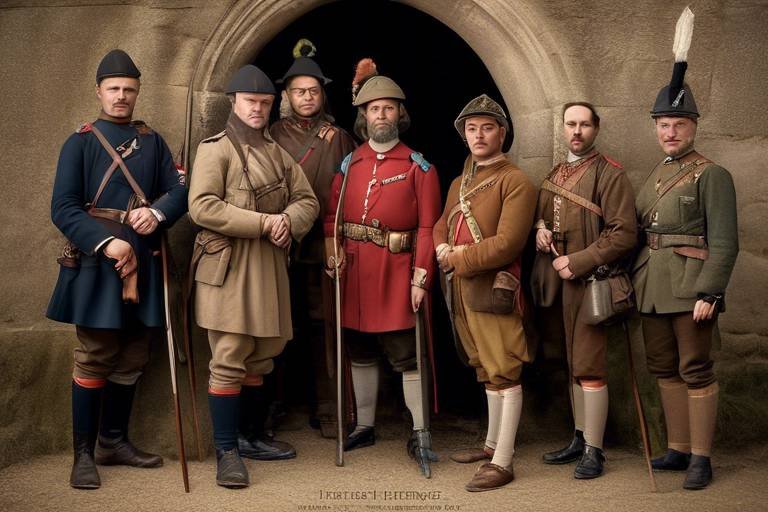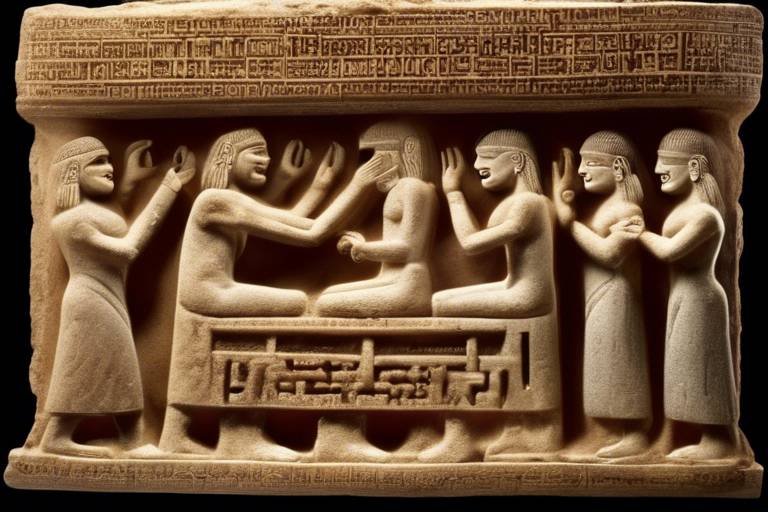The Legacy of the Ancient Maya Civilization
The ancient Maya civilization continues to leave an indelible mark on various aspects of our modern world, from art and architecture to mathematics, astronomy, and culture. Their rich heritage is a treasure trove of knowledge and innovation that has transcended time, offering insights into a sophisticated society that thrived centuries ago.
Maya art stands out for its intricate details and symbolic representations, found in sculptures, murals, and pottery. These artistic expressions not only captivate the eye but also convey profound stories about Maya beliefs, rituals, and daily life. Each piece of art serves as a window into the spiritual and cultural world of the Maya people, showcasing their creativity and ingenuity.
When we gaze upon the architectural marvels of the Maya, such as the majestic pyramids of Tikal and Chichen Itza, we are transported back in time to a civilization that excelled in urban planning and engineering. The grandeur of their structures reflects a society that valued both aesthetics and functionality, leaving a lasting impression on all who behold their magnificence.
The Maya writing system, with its intricate glyphs and codices, is a testament to their intellectual prowess and dedication to record-keeping. Deciphering these hieroglyphics unveils a world of historical records, religious texts, and astronomical knowledge, shedding light on the complexities of Maya society and their quest for understanding the universe.
Exploring the Maya calendar and their astronomical observations reveals a society deeply connected to the celestial realm. Their precise timekeeping methods and celestial alignments not only guided their rituals and agricultural practices but also influenced their governance and societal structure. The Maya's intricate understanding of the cosmos continues to inspire awe and admiration.
The Maya's contributions to mathematics, including the invention of zero and advanced calculation methods, showcase their intellectual sophistication. Their mathematical system, based on positional notation, laid the foundation for modern arithmetic and influenced future developments in the field. The Maya's mathematical legacy is a testament to their innovative spirit and analytical acumen.
Delving into Maya rituals and religious practices unveils a complex tapestry of beliefs and ceremonies that shaped their spiritual worldview. From bloodletting rituals to ball games with religious significance, the Maya's pantheon of gods and myths offers a glimpse into a society deeply intertwined with the divine and the supernatural. Their religious practices were integral to their identity and societal cohesion.
Examining Maya agricultural practices reveals a society attuned to the land and its resources. Through terracing, irrigation systems, and innovative crop cultivation techniques, the Maya sustained a thriving agricultural economy that supported their population growth and societal development. Their commitment to sustainability and environmental stewardship is a lesson for us all.
In conclusion, the legacy of the ancient Maya civilization endures in contemporary society through cultural traditions, language, and ongoing archaeological discoveries. The Maya's influence can be felt in various aspects of our lives, reminding us of a remarkable Mesoamerican culture that continues to inspire and intrigue. Their legacy is a testament to human creativity, resilience, and ingenuity.

Maya Art and Iconography
Exploring the enduring impact of the ancient Maya civilization on art, architecture, mathematics, astronomy, and culture, shedding light on their advancements and traditions that continue to influence modern society.
Delving into the intricate art forms and symbolic meanings behind Maya sculptures, murals, and pottery, showcasing their unique style and the stories they tell about Maya beliefs and daily life. The Maya art is a visual narrative, depicting scenes from daily life, religious beliefs, and historical events. Their intricate carvings and colorful murals offer a window into their rich culture and traditions.
Maya art is characterized by elaborate hieroglyphs, animal motifs, and symbolic representations of gods and mythological creatures. Each piece of art tells a story, whether it's a depiction of a royal ceremony, a mythological tale, or a historical event. The intricate details and vibrant colors used by the Maya artists reflect their deep connection to nature and the spiritual world.
One of the most fascinating aspects of Maya art is its focus on iconography, where symbols and images convey complex meanings and narratives. The use of symbols such as glyphs, animals, and geometric shapes in Maya art adds layers of significance to their artistic expressions, allowing viewers to delve into the depths of Maya culture and beliefs.
Maya art not only served as a form of artistic expression but also as a means of communication and storytelling. Through their sculptures, murals, and pottery, the Maya preserved their history, beliefs, and traditions for future generations to decipher and appreciate.

Architectural Marvels of the Maya
When it comes to the architectural marvels of the Maya civilization, one cannot help but be awestruck by the grandeur and sophistication of their structures. The Maya were master builders, creating impressive pyramids, temples, and cities that still stand as testaments to their advanced engineering skills and urban planning abilities.
One of the most famous Maya sites, Tikal, is a prime example of their architectural prowess. The towering pyramids and intricate temples at Tikal showcase the Maya's ability to construct monumental structures that served both practical and ceremonial purposes. Similarly, Chichen Itza's iconic pyramid, El Castillo, is a striking example of Maya architecture, with its precise alignment to the sun's movements during the equinoxes.
What sets Maya architecture apart is not just the sheer size of their buildings, but also the intricate details and symbolic significance infused into each structure. The elaborate carvings, hieroglyphic inscriptions, and decorative elements found in Maya architecture provide valuable insights into their religious beliefs, cosmology, and societal structure.
Moreover, the layout of Maya cities reflects a deep understanding of urban planning and environmental sustainability. The strategic positioning of plazas, ball courts, and residential areas within Maya city centers demonstrates a harmonious integration of architecture with the natural landscape.
Overall, the architectural marvels of the Maya civilization continue to fascinate and inspire visitors from around the world, offering a glimpse into a bygone era of artistic ingenuity and cultural sophistication.

Maya Hieroglyphics and Writing System
The Maya hieroglyphic writing system is a fascinating aspect of the ancient civilization's culture, providing valuable insights into their history, beliefs, and daily life. The intricate glyphs and codices used by the Maya served as a means of recording important events, religious ceremonies, and astronomical observations. These hieroglyphs were meticulously carved into stone monuments, painted on pottery, and depicted in elaborate murals, showcasing the artistic and linguistic prowess of the Maya people.
Deciphering the Maya writing system has been a monumental task for archaeologists and epigraphers, as each glyph represents a syllable or concept rather than individual letters. The intricate nature of Maya hieroglyphs required a deep understanding of their language and symbolism, allowing researchers to unravel the rich tapestry of historical records and mythological narratives preserved in these ancient texts.
One of the most famous Maya hieroglyphic inscriptions is the Dresden Codex, a pre-Columbian Maya book containing detailed astronomical tables, almanacs, and prophecies. This codex provides valuable insights into the Maya calendar system, celestial events, and religious ceremonies, highlighting the sophisticated knowledge and intellectual achievements of this ancient civilization.
Moreover, the Maya hieroglyphic writing system also played a crucial role in the transmission of knowledge and cultural traditions within the Maya society. Through the intricate glyphs inscribed on stelae, temples, and tombs, the Maya communicated their history, genealogy, and religious beliefs to future generations, ensuring the preservation of their cultural heritage for centuries to come.

Maya Calendar and Astronomy
Exploring the enduring impact of the ancient Maya civilization on art, architecture, mathematics, astronomy, and culture, shedding light on their advancements and traditions that continue to influence modern society.
The Maya civilization's profound understanding of astronomy and timekeeping is exemplified by their intricate calendar system, which intricately intertwined celestial observations with religious beliefs and societal events. The Maya calendar consisted of several interlocking cycles, including the Tzolk'in (260-day ritual calendar) and the Haab' (365-day solar calendar), forming a complex system that guided their daily lives and ceremonies.
Furthermore, the Maya's astronomical knowledge allowed them to accurately predict celestial events such as eclipses and solstices, demonstrating their advanced understanding of the cosmos. By aligning their architectural structures with celestial phenomena, such as the positioning of temples to correspond with the movements of the sun and stars, the Maya showcased their reverence for the heavens and their belief in the interconnectedness of the physical and spiritual realms.
Moreover, the Maya's astronomical observations influenced various aspects of their society, including agricultural practices and governance. By closely monitoring celestial patterns, the Maya could determine optimal planting and harvesting times, ensuring the success of their crops and sustaining their civilization. Additionally, celestial events were often linked to important rituals and ceremonies, highlighting the Maya's deep spiritual connection to the cosmos.
In essence, the Maya's calendar and astronomy not only served as practical tools for timekeeping and agricultural planning but also as profound symbols of their cultural and spiritual beliefs. Their sophisticated understanding of the cosmos continues to fascinate scholars and enthusiasts alike, showcasing the enduring legacy of the ancient Maya civilization in the realm of astronomy and timekeeping.

Maya Mathematics and Zero Invention
The Maya civilization made remarkable advancements in the field of mathematics, pioneering concepts that are still influential today. One of their most significant contributions was the invention of the concept of zero. Unlike other ancient civilizations, the Maya understood the importance of representing the absence of a quantity, laying the foundation for modern arithmetic.
Utilizing a sophisticated mathematical system based on a vigesimal (base-20) counting system, the Maya developed positional notation long before it was adopted in other parts of the world. This positional system allowed them to perform complex calculations with relative ease, showcasing their mathematical prowess.
Moreover, the Maya were adept astronomers, closely studying the movements of celestial bodies and incorporating their astronomical observations into their mathematical calculations. By aligning their calendar system with astronomical events, such as the cycles of Venus and the movements of the sun, the Maya demonstrated a profound understanding of the cosmos.
The concept of zero was a revolutionary breakthrough in Maya mathematics, enabling them to perform intricate calculations and develop precise calendars essential for agricultural planning and religious ceremonies. This invention not only transformed their numerical system but also had a lasting impact on the evolution of mathematics worldwide.

Maya Rituals and Religion
The ancient Maya civilization was deeply intertwined with elaborate rituals and intricate religious beliefs that shaped their daily lives and societal structure. From bloodletting ceremonies to sacred ball games, the Maya engaged in a wide array of rituals to honor their gods, ancestors, and the natural world around them. These rituals were not just religious practices but also served as a means of communication with the divine and maintaining cosmic order.
One of the most fascinating aspects of Maya religion was their complex pantheon of gods and goddesses, each associated with different aspects of life such as agriculture, warfare, and fertility. The Maya believed in a rich spiritual world where deities played a crucial role in influencing human affairs and natural phenomena. Through offerings, prayers, and ceremonies, the Maya sought to appease and communicate with these powerful beings.
Moreover, the Maya had a profound connection with the underworld, known as Xibalba, which was believed to be the realm of the dead and various malevolent deities. Rituals involving bloodletting, sacrifice, and offerings were conducted to honor the gods of the underworld and ensure the balance between the earthly realm and the afterlife.
Another integral part of Maya rituals was the sacred ball game, a symbolic representation of the cosmic struggle between the forces of good and evil. Played in grand ball courts found in Maya cities, this ritualistic sport not only entertained the masses but also held deep religious significance, often culminating in human sacrifices to appease the gods and ensure a bountiful harvest.
Overall, the intricate rituals and religious practices of the Maya civilization reflect their profound spiritual beliefs and the importance they placed on maintaining harmony with the supernatural forces governing their world. These rituals not only shaped their cultural identity but also served as a cornerstone of their society, reinforcing the interconnectedness between the physical, spiritual, and cosmic realms.

Maya Agriculture and Sustainability
Maya agriculture was a cornerstone of their civilization, enabling them to sustain their population and support their complex society. The Maya employed innovative techniques such as terracing, where they carved steps into hilly terrain to create flat surfaces for farming. This method not only prevented soil erosion but also maximized arable land for cultivation, showcasing their ingenuity in adapting to the challenging Mesoamerican landscape.
Furthermore, the Maya excelled in irrigation systems, utilizing canals and reservoirs to manage water flow and ensure consistent hydration for their crops. By harnessing the natural resources available to them, they were able to cultivate a variety of crops, including maize, beans, squash, and cacao. This diverse agricultural system not only provided sustenance for the population but also formed the basis of their economy and trade networks.
Moreover, the Maya practiced crop rotation and intercropping, techniques that promoted soil fertility and minimized the risk of crop failure. By alternating the types of crops grown in a particular area and planting complementary species together, they maintained a balanced ecosystem that supported sustainable agriculture. This holistic approach to farming not only sustained their civilization but also allowed them to thrive in harmony with the environment.

Legacy of the Maya Civilization Today
As we gaze upon the modern world, the legacy of the ancient Maya civilization continues to echo through time, leaving a profound impact on various aspects of contemporary society. From the intricate art forms to the advanced mathematical concepts, the Maya civilization's influence can be felt in numerous fields, enriching our understanding of history and culture.
One of the most striking legacies of the Maya civilization today is evident in the realm of art and iconography. The intricate designs and symbolic meanings found in Maya sculptures, murals, and pottery serve as a testament to their rich artistic traditions. These artifacts not only showcase the creative prowess of the Maya people but also offer insights into their beliefs, rituals, and daily life.
Furthermore, the architectural marvels left behind by the Maya continue to captivate visitors and researchers alike. The towering pyramids, intricate temples, and well-planned cities such as Tikal and Chichen Itza stand as a testament to the advanced engineering skills and urban planning of the Maya civilization. These structures serve as a window into the past, allowing us to marvel at the ingenuity and craftsmanship of this ancient culture.
Moreover, the Maya writing system and calendar have left an indelible mark on modern society. The decipherment of Maya hieroglyphics has unlocked a treasure trove of historical records, religious texts, and astronomical knowledge, shedding light on the complex society and worldview of the Maya people. Similarly, the sophisticated Maya calendar system and astronomical observations continue to influence various aspects of contemporary life, from timekeeping to spiritual practices.
When we delve into the realm of mathematics, the Maya civilization's contributions are equally remarkable. The invention of zero, the development of positional notation, and the sophisticated calculations demonstrate the advanced mathematical knowledge possessed by the Maya. Their mathematical concepts have not only influenced modern arithmetic but also underscore the intellectual achievements of this ancient civilization.
Furthermore, the enduring legacy of the Maya civilization can be seen in their agricultural practices and sustainability efforts. The innovative techniques of terracing, irrigation, and crop cultivation employed by the Maya not only supported their population growth but also laid the foundation for sustainable farming practices. Their agricultural legacy serves as a reminder of the importance of environmental stewardship and resource management in today's world.
In conclusion, the legacy of the ancient Maya civilization continues to thrive in contemporary society, shaping our understanding of art, architecture, mathematics, astronomy, and culture. By exploring and appreciating the achievements of the Maya people, we not only honor their legacy but also gain valuable insights into the complexities of human civilization and the enduring impact of ancient cultures.
Frequently Asked Questions
- What is the significance of Maya art in their civilization?
Maya art played a crucial role in expressing their beliefs, stories, and daily life. It served as a medium to communicate their cultural values and traditions through intricate sculptures, murals, and pottery.
- How did the Maya excel in architecture?
The Maya showcased their architectural prowess through the construction of impressive pyramids, temples, and cities like Tikal and Chichen Itza. Their advanced engineering techniques and urban planning continue to awe visitors to this day.
- What makes the Maya writing system unique?
The Maya writing system, consisting of glyphs and codices, is renowned for its complexity and ability to preserve historical records, religious texts, and astronomical knowledge. It offers valuable insights into their civilization.
- How did the Maya calendar influence their society?
The sophisticated Maya calendar system and astronomical observations were integral to their rituals, agriculture, and governance. Their precise timekeeping methods and celestial connections shaped various aspects of their daily lives.
- What were the contributions of the Maya to mathematics?
The Maya made significant contributions to mathematics, including the invention of zero, positional notation, and advanced calculations. Their mathematical achievements continue to impact modern arithmetic.
- What were the key aspects of Maya religion and rituals?
The Maya had a rich spiritual belief system that involved intricate rituals such as bloodletting ceremonies and ball games. Their pantheon of gods, underworld myths, and religious practices reflected their complex worldview.
- How did Maya agriculture support their civilization?
Maya agricultural practices, such as terracing, irrigation, and sustainable farming techniques, played a vital role in supporting their population growth and societal development. Their innovative farming methods were key to their sustainability.
- What is the lasting impact of the Maya civilization today?
The legacy of the ancient Maya civilization endures in contemporary society through cultural traditions, language, and ongoing archaeological discoveries. Their remarkable contributions continue to deepen our understanding of Mesoamerican culture.



















